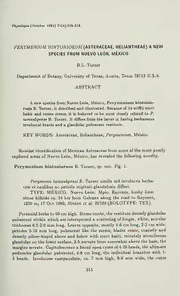
Perymenium hintoniorum (Asteraceae, Heliantheae) a new species from Nuevo León, México PDF
Preview Perymenium hintoniorum (Asteraceae, Heliantheae) a new species from Nuevo León, México
Phyiologia{October 1991) 71(4):315-318. PERYMENIUM HINTONIORUM{^SJER^CE^E. HELIANTHEAE) A NEW SPECIES FROM NUEVO LEON, MEXICO B.L. Turner Department of Botany, University of Texas, Austin, Texas 78713 U.S.A. ABSTRACT A new species fromNuevo Leon, Mexico, Perymeniumhintonio- rum B. Turner, is described and illustrated. Because ofits stiffly erect habit and terete stems, it is believed to be most closely related to P. tamaulipenseB. Turner. It differs from the latterin having herbaceous involucral bracts and a glandular pubescent vestiture. KEY WORDS: Asteraceae, Heliantheae, Perymenium, Mexico Routine identification ofMexican Asteraceaefrom someofthe morepoorly explored areas of Nuevo Leon, Mexico, has revealed the following novelty. Perymenium hintoniorum B. Turner, sp. nov. Fig. 1. Perym.enio tam,aulipensi B. Turner similis sed involucris herba- ceis et caulibus ac petiolis stipitati-glandulosis differt. TYPE: MEXICO. Nuevo Leon: Mpio. Rayones, bushy lime- stone hillside ca. 24 km from Galeana along the road to Rayones, 1230 m, 17 Oct 1990, Hmton et al. 20788 (HOLOTYPE: TEX). Perennial herbs to60 cmhigh. Stems terete,the vestituredenselyglandular pubescent within which are interspersed a scattering oflonger, white, acicular trichomes 0.5-2.0 mm long. Leaves opposite, mostly 4-6 cm long, 2-3 cm wide; petioles 5-10 mm long, pubescent like the stems; blades ovate, coarsely and densely pilose-hispid above and below with erect hairs, minutely atomiferous glandular on the lower surface, 3-5 nervate from somewhat above the base, the margins serrate. Capitulescence abroad open cymeof4-20 heads, the ultimate peduncles glandular pubescent, 4-8 cm long, the individual branches with 1- 5 heads. Involucres campanulate, ca. 7 mm high, 8-9 mm wide, the outer 315 PHYTOLOGIA 316 volume 71(4):315-318 October 1991 trom noioiype. Turner: New Perymenium from Nuevo Leon 317 two series of bracts 10-12, herbaceous throughout, strigose, ovate, subequal, grading into the receptacular bracts, the apices narrowly obtuse to acute. Ray mm mm florets 8, fertile; corolla tubes ca. 1.5 long, the ligules yellow, 8-10 mm mm long, 3-5 wide. Disc florets ca. 20; corollas yellow, ca. 6 long, the tubes ca. 1-5 mm long, the lobes coarsely hispid, ca. 0.6 mm long. Achenes mm (immature) ca. 2.5 high, the pappus of 20-30 deciduous bristles 0.5-3.0 mm long. Perymenium hintoniorum. is clearly closely related to P. tamaulipense B. Turner, both possessing similar habits, terete stems, and alax, open capitules- cence, the ultimate peduncles 4-8 cm long. The former is readily distinguished from the latter by its glandular pubescence and ovate-linear, nonscarious in- volucral bracts. Perym,enium, hxnioniorum, might also relate to the poorly known, more southern, P. cornutum, Brandegee. The latter is one of only two species (the other being P. glandulosum Brandegee) to have glandular fo- liage (Fay 1978). Perym,enium, hintoniorum, a third glandular species, differs from P. cornutum in possessing terete stems (vs. 4 sided) and larger heads mm mm mm mm (involucres ca. 7 high, 8-9 wide; vs. 5-6 high, and 5 wide). The species is named for the remarkable Hinton family: George B. Hinton (1882-1943), whose numerous excellent collections from southern Mexico are widely distributed and well known to botanists working in that area generally (cf. Hinton & Rzedowski 1975); his son, Jaimie Hinton (currently residing with his family on Rancho AguiliUa near the foot of Cerro Potosi, Nuevo Leon) who has extended his father's botanical endeavors through the assembly of a large collection of excellent specimens from Cerro Potosi and environs, and from other regions as well; and to Jaimie's son, George Hinton, named for his grandfather, and who has assisted his father in the botanical exploration of remote regions of Mexico and has taken upon his shoulders the continuance of such activity-a continuation that is likely to extend over three generations and beyond. I mention all of this here because 1 am aware that there already exists a Perymenium hmtonii Fay, named for the grandfather, but, in view of the dedication of the family as a whole, 1 think it appropriate to apply the present eponym so as to call attention to this trigenerational phenomenon. ACKNOWLEDGMENTS I am grateful to Dr. Guy Nesom for the Latin diagnosis, and to him and Dr. Andrew McDonald for reviewing the manuscript. Nancy Webber provided the illustration. PHYTOLOGIA 318 volume 71(4):315-318 October 1991 LITERATURE CITED Fay, J.J. 1978. Revision of Perymenium (Asteraceae - Heliantheae) in Mex- ico and Central America. Allertonia 1:235-296. Hinton, J. & J. Rzedowski. 1975. George B. Hinton, Explorador Botanico en el Sudoeste de Mexico. An. Escuela Nac. Ciencias Biol. 21:1-114.
